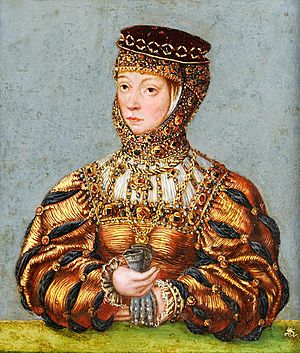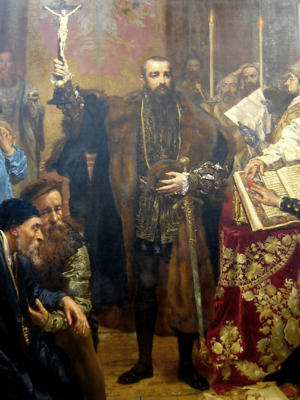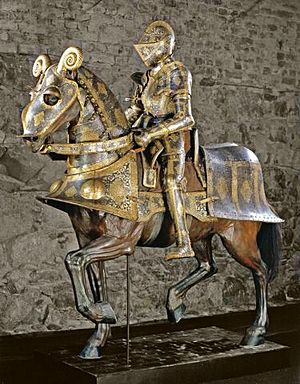Sigismund II Augustus facts for kids
Quick facts for kids Sigismund II Augustus |
|
|---|---|

Portrait by Lucas Cranach the Younger, 1553
|
|
| King of Poland Grand Duke of Lithuania |
|
| Reign | 1 April 1548 – 7 July 1572 |
| Coronation | 20 February 1530 |
| Predecessor | Sigismund I the Old |
| Successor | Henry of Valois (in 1573) |
| Born | 1 August 1520 Kraków, Poland |
| Died | 7 July 1572 (aged 51) Knyszyn, Poland |
| Burial | 10 February 1574 Wawel Cathedral, Kraków, Poland |
| Spouse |
Elisabeth of Austria
(m. 1543; died 1545)Barbara Radziwiłł
(m. 1547; died 1551)Catherine of Austria
(m. 1553; died 1572) |
| Dynasty | Jagiellon |
| Father | Sigismund I the Old |
| Mother | Bona Sforza |
| Religion | Roman Catholicism |
| Signature | |
Sigismund II Augustus (Polish: Zygmunt II August, Lithuanian: Žygimantas Augustas; born August 1, 1520 – died July 7, 1572) was a powerful king of Poland and Grand Duke of Lithuania. He was the son of Sigismund I the Old and became king in 1548.
Sigismund II Augustus was the very first ruler of the Polish–Lithuanian Commonwealth. He was also the last male king from the Jagiellonian dynasty, a very important royal family.
He was the only son of Bona Sforza, who was from Italy, and Sigismund the Old. From a young age, he was prepared to be king and received an excellent education. In 1529, he was crowned while his father was still alive. This was a special tradition called vivente rege.
King Sigismund Augustus believed in treating different groups fairly. He kept peace with other countries, except for the Northern Seven Years' War. This war was fought to protect trade routes in the Baltic Sea. During his rule, Polish culture became very strong and beautiful. He loved collecting art, especially tapestries from the Netherlands, and also military items like swords and armor.
Many people think Sigismund Augustus's time as king was the best part of the Polish Golden Age. He created Poland's first official navy and the first regular postal service, which is now called Poczta Polska. In 1569, he helped sign the Union of Lublin. This important agreement joined Poland and the Grand Duchy of Lithuania to form the Polish–Lithuanian Commonwealth. It also changed how kings were chosen, allowing nobles to elect them.
Sigismund Augustus married three times. He did not have any children. He was the last male member of the Jagiellons. After his sister Anna Jagiellon died in 1596, the Jagiellonian dynasty came to an end.
Contents
Early Life and Becoming King

Sigismund Augustus was born in Kraków, Poland, on August 1, 1520. His parents were King Sigismund I the Old and Queen Bona Sforza. His grandparents were also kings and queens, making him part of a very royal family.
His mother, Queen Bona, watched over him very carefully. Since he was the only son who could inherit the throne, he was given the best education by the smartest people in the country. His mother wanted to name him Augustus, like the first Roman Emperor. However, his father wanted him to be named Sigismund, like himself. They decided he would have both names to solve this disagreement.
In 1530, when Sigismund Augustus was just ten years old, he was crowned as a co-ruler with his father. This was done to make sure he would become king after his father. It also helped the Jagiellonian dynasty stay in power. This move helped calm down nobles who were against the Jagiellons. They thought this step might lead to a king with too much power. This law was later changed in 1573.
Sigismund Augustus started ruling as the Grand Duke of Grand Duchy of Lithuania in 1544. At first, he did not want Poland and Lithuania to fully unite. He hoped to pass his Lithuanian throne to his own children.
His Marriages and Family Life
Sigismund Augustus married three times, but he never had any children. This was a big problem because it meant his family line, the Jagiellonian dynasty, would end with him.
First Marriage to Elizabeth of Austria

When Sigismund Augustus was crowned as co-ruler, a marriage was planned for him. He was to marry Elizabeth of Austria. She was the daughter of Emperor Ferdinand I. The marriage agreement was signed in 1530, but Queen Bona Sforza, Sigismund's mother, did not like Elizabeth. She tried to stop the marriage.
On May 5, 1543, Elizabeth arrived in Kraków. She was 16, and Sigismund Augustus was 22. They met for the first time just before their wedding at Wawel Cathedral. The celebration lasted for two weeks. Queen Bona continued to cause problems for Elizabeth. So, the young couple decided to live in Vilnius, away from the royal court.
Their marriage was not happy. Sigismund Augustus did not find Elizabeth attractive. Elizabeth was also shy and nervous. The king was also put off by Elizabeth's epilepsy and seizures. Only Sigismund the Old and some nobles showed kindness to the new Queen. Sigismund Augustus did not care about her health. He even left her to collect her dowry when her seizures got worse. Elizabeth died on June 15, 1545, at only 18 years old. She was exhausted from her illness.
Second Marriage to Barbara Radziwiłł

After Elizabeth's death, Sigismund Augustus secretly married Barbara Radziwiłł. She was a Lithuanian noblewoman and had been his mistress. He announced their marriage on February 2, 1548. This marriage caused a lot of anger among the Polish nobility and his mother, Queen Bona. They thought Barbara had tricked the king.
The nobles even threatened to stop supporting the king if he did not leave Barbara. Sigismund Augustus even thought about giving up his throne. But by 1550, some nobles started to support him. Queen Bona was also sent away from Wawel Castle.
Barbara was not liked by the royal court. She lived a quiet life with Sigismund Augustus, who loved her deeply. She was smart and had great taste in fashion. Their love story is seen as one of the greatest in Polish history. Sigismund even built a secret passage to meet her when he was still married to Elizabeth.
Barbara wanted to live in Lithuania, her homeland. To make her happy, Sigismund Augustus gave her a luxurious life and expensive gifts. He also gave her control over several areas to provide her with money. Barbara was smart but did not care much for politics. However, she did have some influence over the king's decisions.
To avoid a rebellion, Sigismund made an alliance with Emperor Ferdinand I. This helped Barbara be crowned Queen of Poland on December 7, 1550. Queen Bona finally accepted the marriage.
Barbara had always been sick, complaining of stomach pain. After her coronation, her health got much worse. She had a high fever, diarrhea, and no appetite. Doctors found a lump on her stomach. Sigismund Augustus was very worried. He sent for doctors and healers from all over the country. He personally took care of her. Barbara died on May 8, 1551, in Kraków.
It was her last wish to be buried in Lithuania. Her body was taken to Vilnius Cathedral, where she was buried next to Elizabeth of Austria. Sigismund was heartbroken. He became more serious and wore black clothes until he died. People rumored that Queen Bona had poisoned Barbara. However, historians today believe she died from cervical or ovarian cancer.
Third Marriage to Catherine of Austria

After Barbara's death, Sigismund had to marry again for political reasons. He married his first cousin, Catherine. She was also the sister of his first wife, Elizabeth. This marriage was meant to stop Austria from forming an alliance with Russia.
Catherine was seen as plain and overweight. Sigismund Augustus did not find her attractive, even though he agreed to the marriage. Catherine also resented Sigismund for how he treated her sister, Elizabeth. Their letters to each other were only about politics.
Catherine acted as Austria's spy at the Polish court. She tried to get information for the Habsburg family. Sigismund Augustus knew about this. But by marrying Catherine, he got Austria to promise to stay neutral and not ally with Russia. When Sigismund found out about Catherine's secret plans, he sent her away from political life.
Sigismund had no children with Catherine. Since he was the last male Jagiellon, his family line was in danger of ending. The parliament was willing to accept any male child he might have as his successor. But the king remained childless.
Health and Final Years

Sigismund Augustus was often sick. When he was 16, he got malaria, which might have affected his ability to have children. By 1558, he had gout, and from 1568, he suffered from painful kidney stones. He hired many doctors and bought expensive medicines. Towards the end of his life, he was losing teeth and strength, possibly from tuberculosis.
In the spring of 1572, Sigismund Augustus got a fever. His untreated tuberculosis made him weak. He traveled to his private home in Knyszyn. There, he wrote to his diplomats and nobles, saying he felt well. However, others reported that the king was bleeding badly and had chest pain.
Sigismund died in Knyszyn on July 7, 1572. He was surrounded by senators and envoys. Doctors said he died from consumption (tuberculosis). His body was taken to Tykocin Castle and later to Wawel Cathedral in Kraków. He was buried on February 10, 1574. His funeral was very grand, the last of its kind for a Polish king.
His death meant that Poland would no longer have kings from the Jagiellonian family. Instead, kings would be chosen by election, a system that lasted until the end of the 18th century.
Key Achievements of His Reign
Sigismund's time as king was a period of peace and growth for Poland. He saw the peaceful start of the Protestant Reformation in Poland and Lithuania. He also saw the Polish nobility gain more political power. He was a skilled leader and diplomat.
Livonia and Baltic Trade
During Sigismund Augustus's reign, the region of Livonia was in chaos. His father had allowed Protestantism to spread there. This led to conflicts between Catholics and Protestants. Sigismund Augustus, though Catholic, stepped in to help the Protestants.
In 1557, Polish forces went to Livonia. They were successful, and many Livonian lands came under Polish protection. This agreement angered Ivan the Terrible of Russia, who wanted to expand into the Baltic region. On January 22, 1558, Ivan invaded, starting the Livonian War. This war lasted 25 years. Russia was eventually defeated, and Livonia was divided between Poland and Sweden. The Polish part became known as Polish Livonia.
Northern Seven Years' War
The breakup of the union between Sweden and Denmark in 1523 threatened trade in the Baltic Sea. The important port city of Gdańsk, Poland's richest city, faced problems from sea conflicts and piracy. Trade routes from the Baltic to Kraków were also affected.
Gdańsk did not want to follow Sigismund's orders to send privateers and create a Polish navy there. Many city leaders were merchants who supported Sweden or wanted Gdańsk to be an independent city-state. When 11 Polish privateers sent by Sigismund were executed, the king was very angry. Poland then joined Denmark against Sweden to control the Baltic Sea.
The war ended in 1570. Although it did not change much, it led to the creation of Poland's first official naval fleet in 1568.
Union of Lublin: Creating a New State

Sigismund's most important achievement was the Union of Lublin. This agreement united Poland and Lithuania into one large state, the Polish–Lithuanian Commonwealth. This huge step might not have happened without the king's personal skills in politics and mediation.
At first, Lithuanian nobles worried they would lose power. However, the union would create a strong alliance against attacks from Russia. Lithuania had been fighting wars with Russia for over 150 years. The Poles were also unwilling to help Lithuania without a good reason.
As another war with Russia seemed likely, Sigismund Augustus pushed for the union. He slowly gained more supporters with his strong arguments and good diplomacy. The king was determined. He wanted to preserve his family's legacy since he had no children. The new union would create one large Commonwealth, with one elected king ruling both areas.
Negotiations for the union began in January 1569 in Lublin. They were difficult. The Lithuanians questioned the right of Poles to own land in Lithuania. When some Lithuanian leaders left the talks, Sigismund announced that several Lithuanian provinces would become part of Poland. Local Ukrainian nobles in these areas supported this change.
The Lithuanians were forced to return to negotiations. They eventually agreed to form a federal state on June 28, 1569. On July 1, 1569, the Union of Lublin was signed at Lublin Castle. Sigismund Augustus approved the act on July 4. From then on, he ruled one of the largest and most diverse countries in 16th-century Europe.
Religion and Tolerance
Compared to his very Catholic father, Sigismund Augustus was more relaxed about religion. He was quite tolerant of different faiths. He allowed nobles of various religions and backgrounds to be part of the national assembly, the Sejm. He continued his father's policies but was more accepting of the Protestant Reformation in Poland.
Many important nobles became Protestants during this time. Calvinism became very popular among the upper classes. It promoted democratic freedoms and challenged absolute rule, which the Polish nobility liked. In 1555, nobles discussed creating a separate Polish Church, similar to the Church of England. Sigismund agreed, but only if the Pope approved.
However, Pope Paul IV was very angry and refused. The assembly had to give up their plans to avoid being kicked out of the Church. Still, Protestantism continued to grow. In 1565, the Polish Brethren, a new Protestant group, was formed.
One year after Sigismund's death, the Warsaw Confederation was signed. This was the first European law to grant religious freedoms. However, Protestantism later declined in Poland due to strong efforts by the Catholic Church.
Patron of Arts and Culture
Sigismund Augustus continued to improve royal homes like Wawel Castle, Vilnius Castle, and the Royal Castle, Warsaw. In the 1560s, he bought and rebuilt Tykocin Castle in the Renaissance style. This castle became a royal home with a large treasury, library, and main weapons storage.
Sigismund Augustus loved collecting jewels and gemstones. He had 16 chests full of them. His collection included a valuable ruby from Charles V, Holy Roman Emperor and a diamond medal. He also owned a sultan's sword and many expensive horse decorations and armors. The king had a huge collection of Jagiellonian tapestries (360 pieces) that he ordered from Brussels.

The king enjoyed reading, especially short stories, poems, and satires. He brought Poland's greatest writer and poet, Jan Kochanowski, to his royal court in 1563. Kochanowski often helped the king at important events, including military exercises and the signing of the Lublin union.
Sigismund also hired foreign artists and craftsmen, especially Italian goldsmiths and jewelers. One famous artist he brought to Poland was Jacopo Caraglio. Caraglio made cameos, medallions, coins, and jewelry for the king.
In 1558, the king started the first regular Polish postal service. It ran from Kraków to Venice, establishing Poczta Polska (Polish Post). The king paid for all the costs. This postal service helped him communicate with the Habsburgs and other rulers.
In 1573, the first permanent bridge over the Vistula River in Warsaw was named in Sigismund's honor. It was the longest wooden bridge in Europe at that time.
Royal Titles
- Royal titles, in Latin: "Sigismundus Augustus, Dei gratia rex Poloniae, magnus dux Lithuaniae, nec non terrarum Cracoviae, Sandomiriae, Siradiae, Lanciciae, Cuiaviae, Kiioviae, dominus hereditarius Russiae, Woliniae, Prussiae, Masoviae, Podlachiae, Culmensis, Elbingensis, Pomeraniae, Samogitiae, Livoniae etc. dominus et heres."
- English translation: "Sigismund Augustus, by the Grace of God, King of Poland, Grand Duke of Lithuania, Lord and heir of the Lands of Kraków, Sandomierz, Sieradz, Łęczyca, Kuyavia, Kiev, Hereditary Lord of Ruthenia, Volhynia, Prussia, Masovia, Podlaskie, Culmer Land, Elbing, Pomerania, Samogitia, Livonia etc. Lord and heir"
See also
 In Spanish: Segismundo II Augusto Jagellón para niños
In Spanish: Segismundo II Augusto Jagellón para niños







